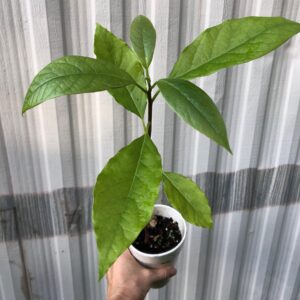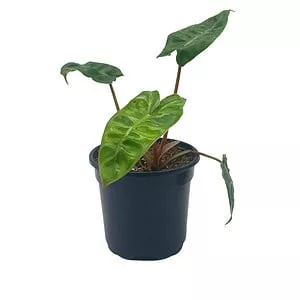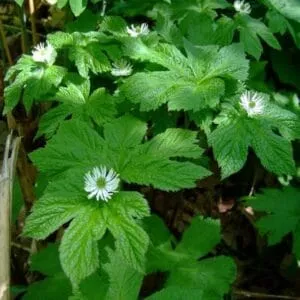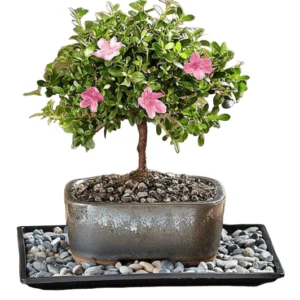No products in the cart.
Rhapis Excelsa lady palm is one of those easy-to-care-for indoor plants that could be a great gift for anyone, including beginners.
So today, we will be talking about lady palm care and what it needs to grow big and happy.
It is characterized by slender yet strong stems and broad leaves, which is why you can get across the name of “broadleaved palm” when referring to Rhapis Excelsa.
The Lady palm has many other names – bamboo palm, finger palm, or fan palm.
It is both an indoor and outdoor plant and it is really versatile when it comes to soil, water, and other requirements, which is why Rhapis palm is one of the most well-known and most popular plants.
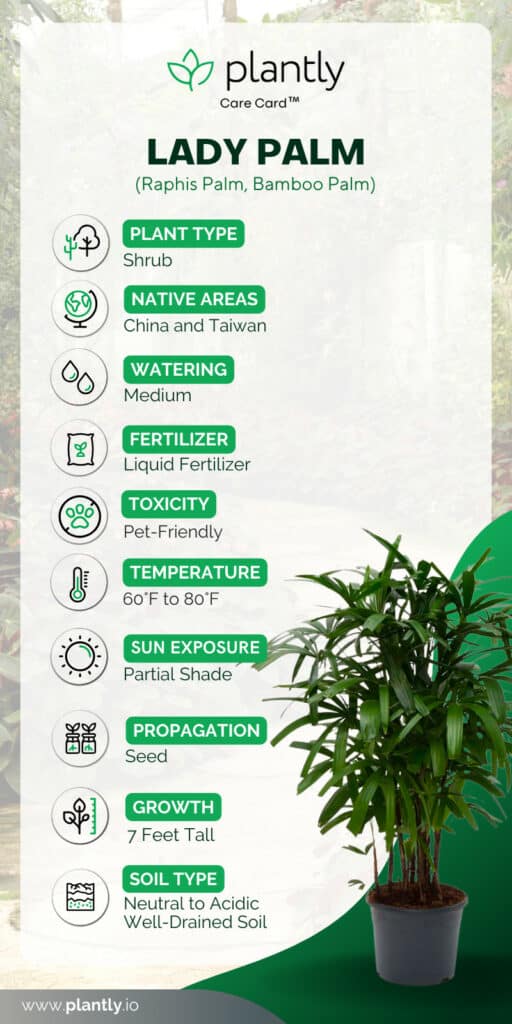
Lady Palm Care
If you care for a lady palm plant correctly it will give you years of satisfaction.
It has several varieties, yet the care process is the same for all of them. And not difficult at all.
Outdoors, Raphis palm can grow up to 3.5m (12 ft).
Indoors its height depends on the pot size.
Here is what lady palms like when it comes to their care.
Water requirements
When it comes to water, a Lady palm needs well-draining soil that will not retain too much of the water.
The best time for watering lady palm when it is kept indoors is when the top inch of the soil is dry.
During the colder months, you can wait a bit longer as it can withstand shorter periods without watering.
This is why it is a good beginner plant – it will not die if you skip watering it once or twice.
Rhapis Excelsa likes its soil moist (not drenched!), so water until you see water gathering in the pot plate, and spill the excess water after about half an hour.
This will prevent the soil from retaining too much moisture that can cause root rot.
In the case of this pretty palm – less water is better than overwatering.
Ideally, keep the soil moist constantly.
Lighting and Temperature requirements for Lady Palm
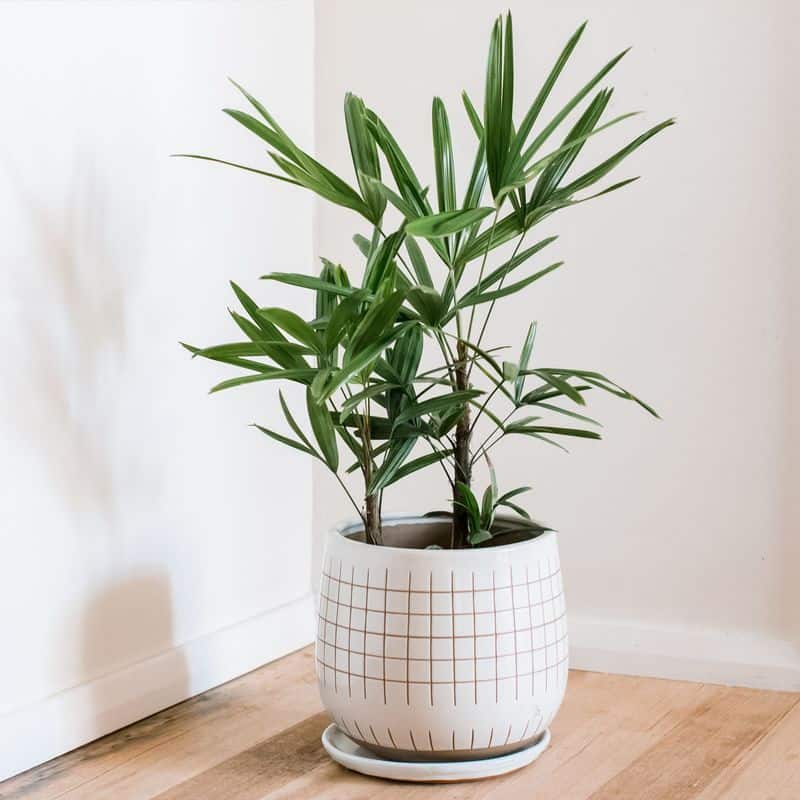
As an outdoor plant, lady palm can thrive in both tropical and subtropical climates.
What does it mean for you?
It means that it likes shade or partial shade and no exposure to direct light.
When you are caring for an indoor Rhapis palm, follow the same rule.
If you need to choose between direct light and total shade, pick the latter.
Exposure to direct sunlight causes browning of the leaves’ edges or even whole leaves if the exposure periods are longer.
Filtered indirect light would be your best bet.
To manage that, keep your plants in a corner, or on a tabletop near a window.
You can also use curtains to shade the Lady palm tree.
If you have the option, position the plant near an east-facing window as the morning sun is not as strong and hot as the afternoon sun it would be exposed to in a south or west-facing window.
Bonus tip: Rotate the pot from time to time in one-quarter turns in the same direction.
It will allow the plant to grow evenly on each side. Otherwise, the side facing the window will be more developed than the other.
When it comes to the temperature, here is a rule: If it is pleasant for you, it will be pleasant for your Rhapis palm.
It likes moderate temperatures (60°-80° F), and makes sure that the temperature does not go below 55° F.
Lady palms prefer a more humid environment with 50% or higher humidity rates, yet they can tolerate lower levels of humidity.
-
$17.95Sold By: SunSoul Plants
$23.95In stock
Avocado seedlings potted in 5″ pot, young starter plants
Only 3 available and it’s in 1 people’s basketRated 4.87 out of 5 based on 98 customer ratings00Sold By: SunSoul Plants -
$12.99Sold By: BubbleBlooms
In stock
Silver Squill Leopard Plant, Ledebouria socialis, 4 inch
Rated 4.81 out of 5 based on 279 customer ratings00Sold By: BubbleBlooms -
$44.99Sold By: BubbleBlooms
In stock
Philodendron Billietiae
Rated 4.81 out of 5 based on 279 customer ratings00Sold By: BubbleBlooms -
$9.00Sold By: JLP farms TN
$10.00In stock
5 Goldenseal Bareroot
Only 43 available and it’s in 3 people’s basketRated 4.85 out of 5 based on 602 customer ratings22Sold By: JLP farms TN
Soil needs and fertilization
It was already mentioned Lady palm care includes moist, well-draining soil.
It also likes soil that is neutral or acidic, which means it will have to be soil that is rich in organic matter and nutrients.
A good store-bought option would be the soil used for African violets.
You have to be very careful not to over-fertilize lady palms as they can have more damage than benefits from that.
Use a 10-10-10 fertilizer only in the active growth period (April through September) and only according to the packaging instructions.
Pruning and Propagation
Lady palm trees will grow without too much pruning.
You can remove leaves that are brown, yellow, or damaged. Just don’t overdo it.
If over half of a leaf’s surface is damaged, then remove it.
Simply pinch it off or use a sterilized tool to do so.
When only tips or edges are brown, leave them on – it will not harm the palm’s appearance as much as missing several leaves.
Lady palm care includes propagation as well.
Propagating lady palms is done through seeds and is recommended that only experienced gardeners or nurseries do so.
Lady palm grows very slowly and usually spends over 2 full years in the nursery before it is ready to be sold.
So you will usually buy an already strong and grown plant, rather than propagate yourself.
Repotting Lady palm
Outdoor, Lady palm grows freely and can grow to its maximum height if other conditions are met.
It is a different situation for indoor plants.
They grow as big and as tall as the pot allows them to.
You can repot your lady palm every couple of years.
If you want it to grow, repot it in a pot larger by size.
The extra room in the pot will allow the palm to grow bigger.
If your lady’s palm has reached the desired size, you should also repot it every two years.
Whether you disinfect the old pot and place it back, or change the pot completely, the new soil will give your lady palm a boost in terms of nutrients and fresh soil.
Lady palms grow slowly so do not worry if it seems as if it is not growing at all.
Lady Palm Similar Plants
- Kentia palm features graceful, arching fronds and an elegant, feathery look resembling lady palm.
- Parlour palm is another compact option suitable for indoor growing like lady palm, with glossy green leaf segments.
- Rhapis palm is a durable, easy care alternative to lady palm with wide fan leaves divided into finger-like segments.
- Bamboo palm is comparable to lady palm when young in terms of size and structure, with lush green pinnate fronds.
Lady Palm Common Problems
If you care for Lady palm properly, it does not have too many problems.
If you keep it away from the direct sunlight you will avoid burning and browning the leaves.
To avoid chemical burns, use fertilizers sparingly.
Root rot will not be an issue if you do not over-water.
Scales and mites are the only pests that it is susceptible to but can be fixed by using systemic insecticides and rubbing alcohol.
Whether you want to buy, sell or simply reach out to other plant enthusiasts, Plantly is the right place to be!
-
$12.00Sold By: Sparkys Thriftway
In stock
Raven ZZ plant well rooted in 6” pot
Rated 5.00 out of 5 based on 1 customer rating00Sold By: Sparkys Thriftway -
$19.99Sold By: BubbleBlooms
In stock
Red Bromeliad, 4 inch, Guzmania monostachia
Only 89 available and it’s in 2 people’s basketRated 4.81 out of 5 based on 279 customer ratings00Sold By: BubbleBlooms -
$5.00Sold By: Sparkys Thriftway
In stock
uniheat heat packs
Rated 5.00 out of 5 based on 1 customer rating00Sold By: Sparkys Thriftway -
Free Shipping$111.40Sold By: BONSAI WORLD LLC
Only 1 left in stock
Azalea bonsai tree flowers pink or red 8 inch pot
Sold By: BONSAI WORLD LLC
